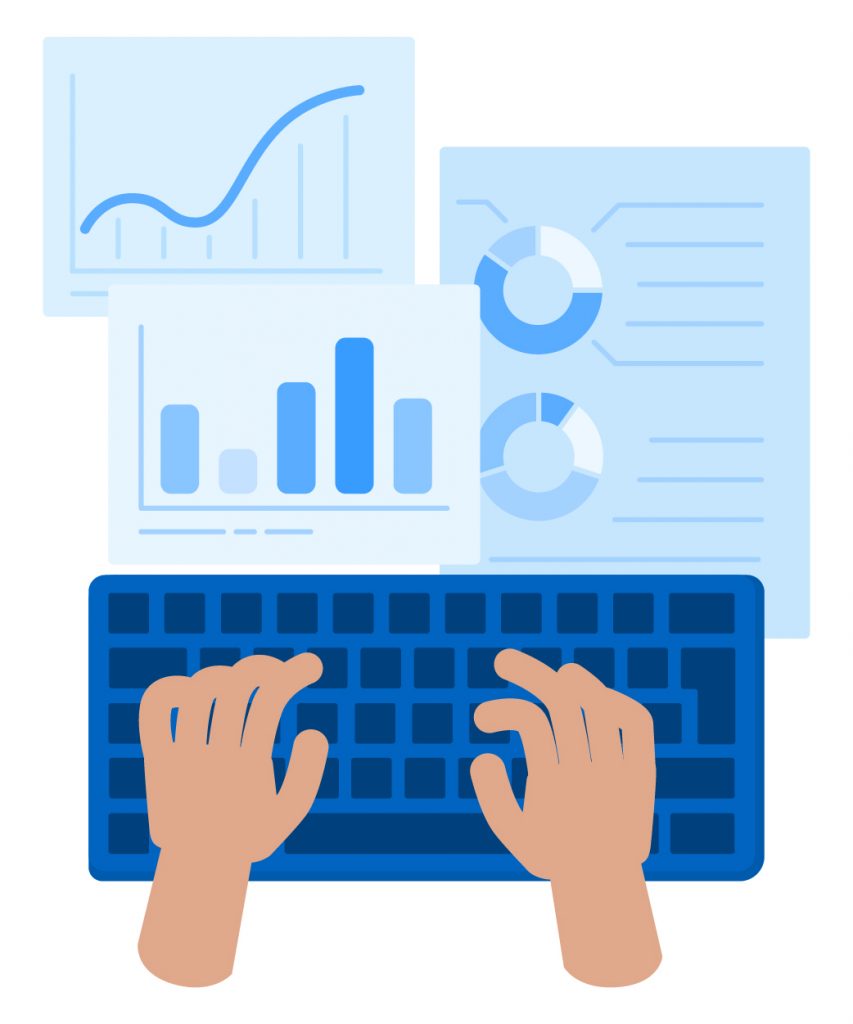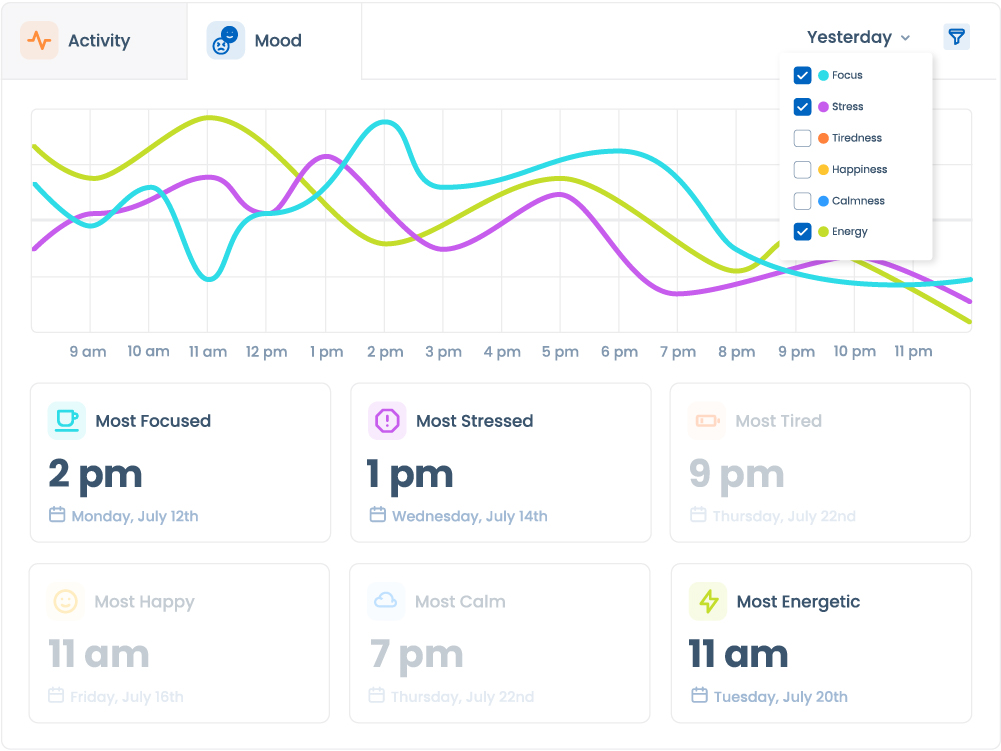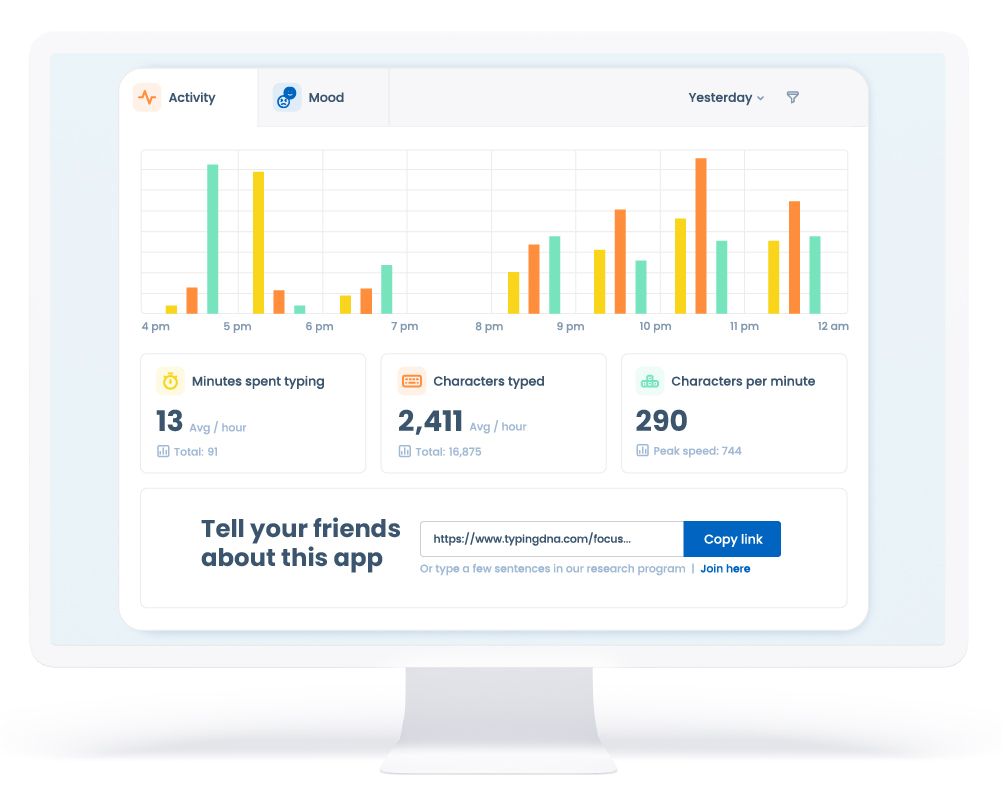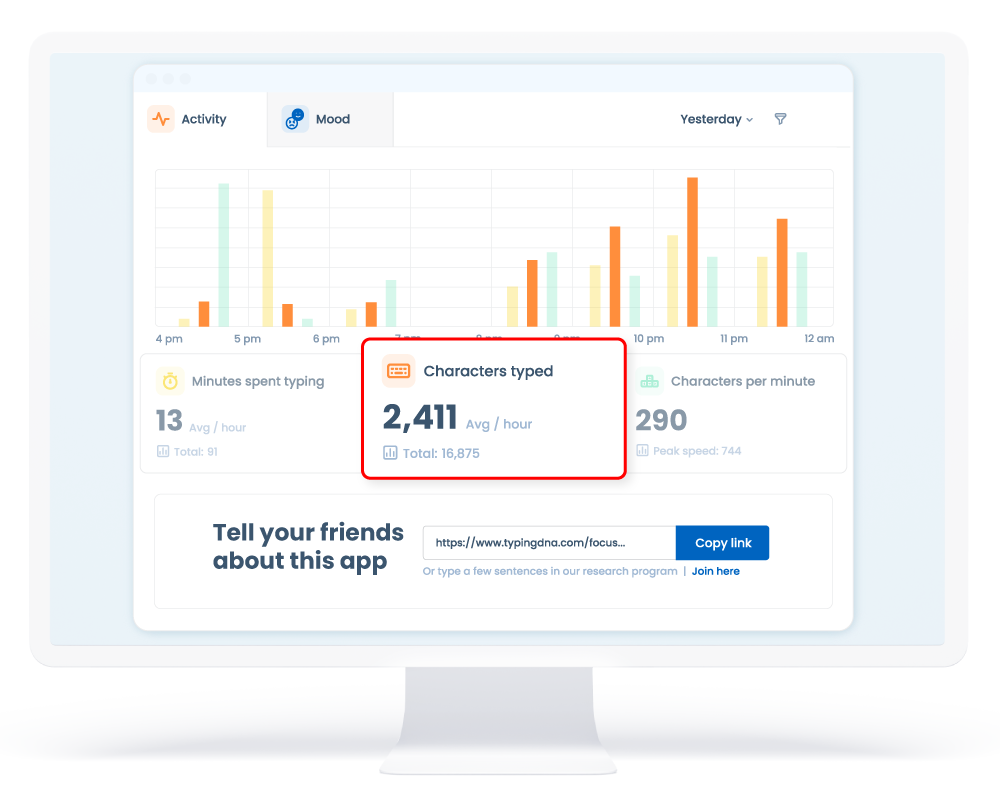Users keen on improving their KPH (keystrokes per hour) rates through practice can now also gain new insights to help uncover analytics about focus and mental well-being.
With TypingDNA Focus, users can track their keystrokes per hour, having access to analytics about characters typed, characters per minute, and minutes spent typing. Track your daily improvements and see hourly breakdowns of typed characters per minute and the peak typing speed.
Download the app for free and get instant access to your typing activity.

Keep reading this article to learn more about:
- What a typing test is
- How typing practice improves memory, helps you code faster, and enables you to excel at data-entry jobs
- How taking a 15-minute test every day can improve your typing skills
- TypingDNA Focus: AI to analyze human emotions based on typing patterns
- What is a good keystroke per hour?
- Converting WPM and CPM to keystrokes per hour
- Identifying emotional states with keystroke dynamics
- How TypingDNA Focus helps you understand your state of mind
What is a typing test?
A typing test is a test that measures typing speed and accuracy. Most typing tests look at three indicators:
- The number of words typed per minute, known as WPM or words-per-minute
- The number of errors made during typing the text, and
- The adjusted words per minute, which looks at any errors made while typing

Typing tests vary depending on the type of text imputed while typing; some include a normal text passage typically containing a few numbers or a few simple symbols — such as quotation marks and question marks.
Some typing tests refer to transcripts and analyze the ability to turn spoken words into an accurate written recording. These audio transcriptions are looking to test the understanding of spoken language and the text’s accuracy. Another type of test is looking at data entry in fields with high accuracy. Usually, numerical or text-based data — including addresses, names, company names, and Social Security numbers — are requested to be inputted rapidly and accurately.
How to improve memory, code faster, and excel at data-entry jobs with typing practice
Typing speed and technique is correlated with better memory, faster coding, and the desired skill for most data entry jobs. According to various studies, practicing typing can improve memory, language, and motor skills.
Typing involves interaction between language, visual, and motor skills simultaneously. When typing, many different parts of the brain are activated, and typing can be a brain-building exercise increasing neural pathways and improving function and memory consistently over time.
Typing engages motor skills as well as language processing centers and strengthening connections across the entire brain. Muscle memory in fingers and hands is built by remembering the keys’ position and the spacing between them. The second memory type refers to the language and spelling of different words combined with all of the different keys’ functions.
Typing proficiency can be improved over time, and skills can be enhanced with proper typing practice and progress monitoring. When typing is part of a recruitment process, depending on the company and job profile, organizations look at different indicators, ranging from speed to accuracy and special symbols. Some positions in which applicants are asked to take a typing test to check for WPM and accuracy include secretarial work, assistant roles, transcription, data entry, emergency services operators, and even software engineers.
How taking a 15 minutes test per day can improve your typing skills
Assessing individuals’ states of mind during keystrokes per hour tests is now possible with typing biometrics technology and records that show how users type. This enables them to discover when they’re most focused, tired, or stressed.
Taking a daily 15-minute typing test delivers a number of benefits and helps track the individual’s typing evolution. Since fast typing is regarded as fundamental cognitive learning for children — just like reading and writing — adults can gain benefits by improving accessibility to a broader range of higher-paid jobs.
With an improved WPM, users will also notice reduced mental and physical fatigue, since faster typing means finding the individual keys in less time. Health issues — such as repetitive stress injuries (RSI) or Carpal Tunnel Syndrome (CTS) — are a significant concern for millions of people who type during a large part of their workday.
TypingDNA Focus uses AI to analyze human emotions based on users typing patterns and helps them improve focus and mood tracking.
In 2021, typing tests come in different forms and lengths and can offer a range of characteristics that can be used to improve typing speed and deliver other benefits — such as memory training.
Still, a short test reflects the status of a limited period, an average of five minutes or less.
TypingDNA has developed Focus, a unique app that uses a new typing biometrics technology designed to help users better understand their typing activity and even leverage this data for better focus and improve productivity.
The AI-based technology provides a multitude of statistics and complex analyses of typing patterns, showing mood statistics such as stress, focus, and tiredness levels. In the app, continuous statistics are provided, including minutes spent typing and characters per minute.

The app uses AI to transform the way users interact with the keyboard to gain insights based on their typing behavior. It also enables users to see weekly trends, their daily activity breakdown, the engagement window, and immediate mood analysis, which can be leveraged to improve focus.

What is a good keystroke per hour?
Keystrokes per hour (KPH) is just a more precise metric than words per minute typed. This number provides a better understanding of the speed and accuracy of a user’s typing capabilities. Words vary in length, so typing speed calculated per hour is more accurate and provides better insights. A good keystroke per hour is around 10,000 keystrokes, but the average user score is approximately 8,000 keystrokes per hour.
The characters per minute metric expresses the speed of the typed characters during a minute. Unlike the word per minute standard measurement, the CPM is more precise since the words vary in length, but characters will always reflect the time spent to input more accurately since it also includes the spaces between words. On average, a person types between 190 and 200 characters per minute.
The entry speed per minute, as seen above, can be expressed in keystrokes per minute, characters per minute (including spaces), and words per minute. A word is standardized to five characters or keystrokes in the WPM measurement, including spaces and punctuation. That being the case, more lengthy words would count as two (e.g., rhinoplasty).
WPM scores vary from person to person. But, on average, a user types 41.4 words in one minute while the fastest English language typist, Barbara Blackburn, reached a typing speed of 212 wpm in 2015 using a Dvorak simplified keyboard. WPM (words per minute) can also be transformed into keystrokes per hour (kph) using these general guidelines: 40 wpm = 10,000 kph; 50 wpm = 12,500 kph; 60 wpm = 15,000 kph.
How to convert WPM and CPM to keystrokes per hour
When converting keystrokes per hour to WPM and CPM, the formula is as follows: keystrokes per hour/60 = kpm (keystrokes per minute).
To calculate the WPM, follow this: keystrokes per minute/5= WPM. The average CPM or keystroke per hour is 15,000 — or 60 words per minute. Using an online typing program like TypingDNA Focus, users can gain access to various statistics, including average CPM. More importantly, the data is displayed like a typing journal.
How to identify emotional states with keystroke dynamics
Advancements in data science and AI can now be translated into better insights based on each individual’s typing pattern, resulting in an accurate mood prediction.
TypingDNA Focus has been specifically developed to help users improve their focus and mental health by analyzing when the periods in which they are most stressed or productive. The insights are provided without any conscious effort from the user; while the app works in the background, professionals or casual typers can use their PCs as they usually would.
TypingDNA Focus also provides insightful statistics about keyboard interactions that can help predict the user’s mood. Stress levels are highlighted throughout the day while the app acts as a mood tracker — even on an hourly basis.
How to use Focus as an alternative to keystrokes per hour test
TypingDNA Focus is available for anyone interested to get hourly, daily, or even weekly statistics of their characters per minute, the average characters typed per hour, and the peak speed. Also, the app will display the minutes per hour spent typing. This data is available in the activity tab of the Focus app dashboard. Users would need to type at least 300 characters to get the first glimpse into their typing activity.
The unique app can also be used as an alternative keystrokes per hour test, which is especially valuable for professionals training to achieve better typing speed results. The daily or weekly statistics include CPM’s graphics easily comparable to past data allowing users to track progress.

TypingDNA Focus is a privacy by design app that combines new typing biometrics technology with high accuracy rates to provide unprecedented data about typing behavior. TypingDNA Focus does not receive users’ typing patterns, and the entire prediction and analysis process occurs on the user’s machine, locally, without sending data to any cloud locations.
How TypingDNA Focus helps you understand your state of mind
Acting as a noninvasive and nonintrusive fitness tracker for the mind, Focus provides statistics about when users are tired, focused, or stressed. That data can then be analyzed to enhance productivity.
This unique use case of typing biometrics comes as a natural response to the current state of individuals experiencing burnout, high anxiety, and stress levels — and the overall inability to focus on tasks and get productive.
According to the Anxiety and Depression Association of America, stress over a long period leads to anxiety and depression, disorders associated with severe chronic diseases.
TypingDNA Focus aims to help users better understand how and when they focus and gain visibility and control over the stressful periods during a day. Additionally, users get insights based on their typing times, characters per minute, and typing behavior, and they can also see weekly trends. Add it all up, and TypingDNA Focus is the easiest way to help your team figure out how to work most productively.
For more information on TypingDNA Focus or to take it for a spin, check this out.

